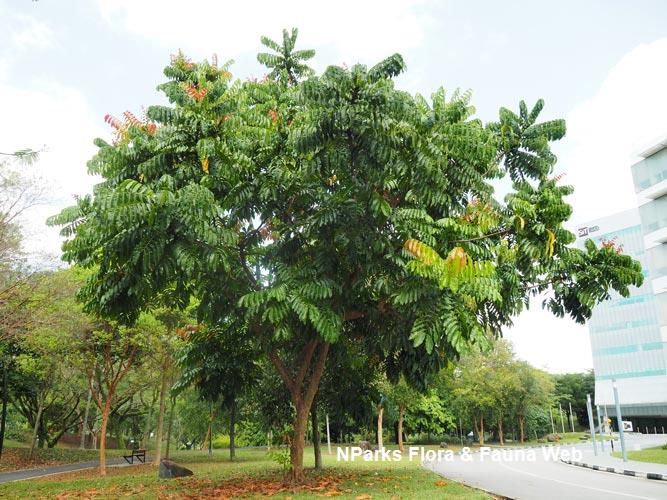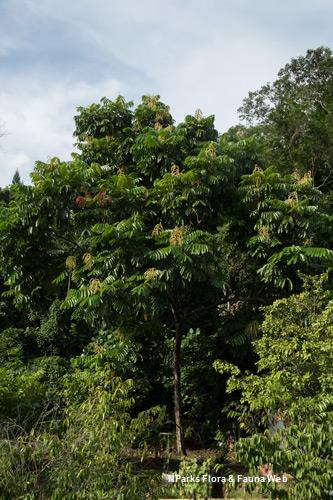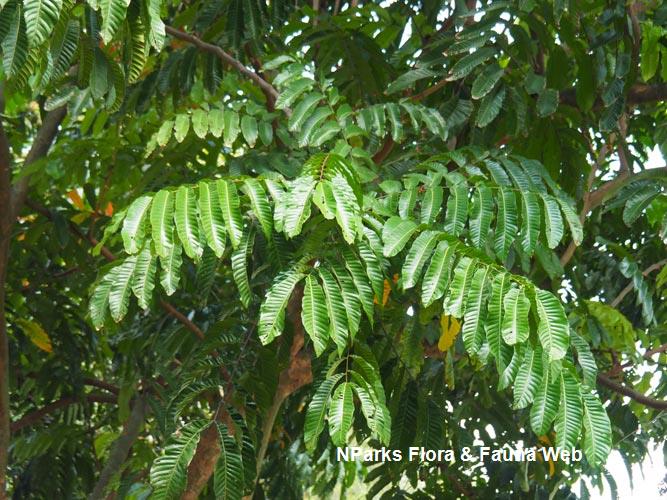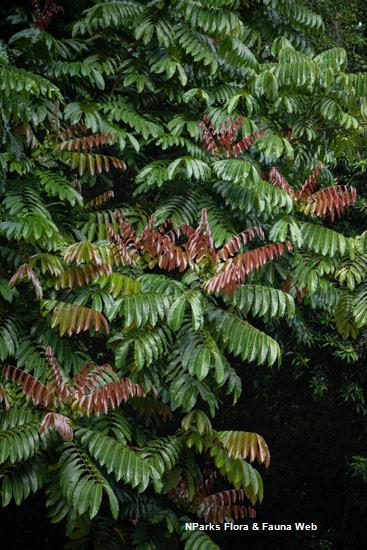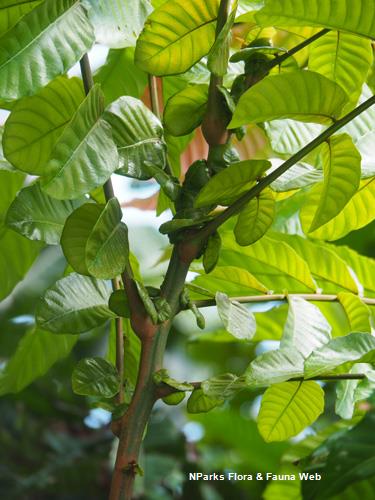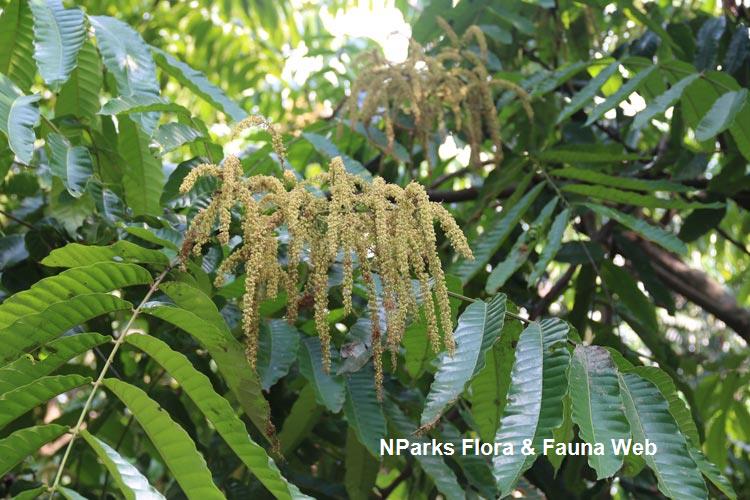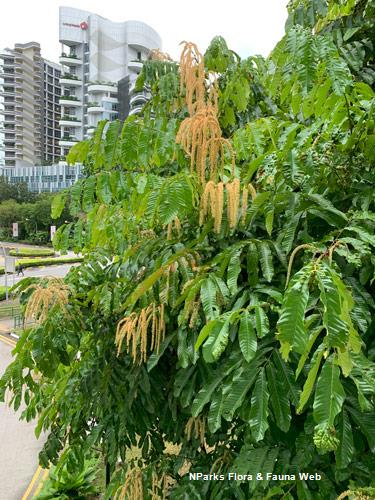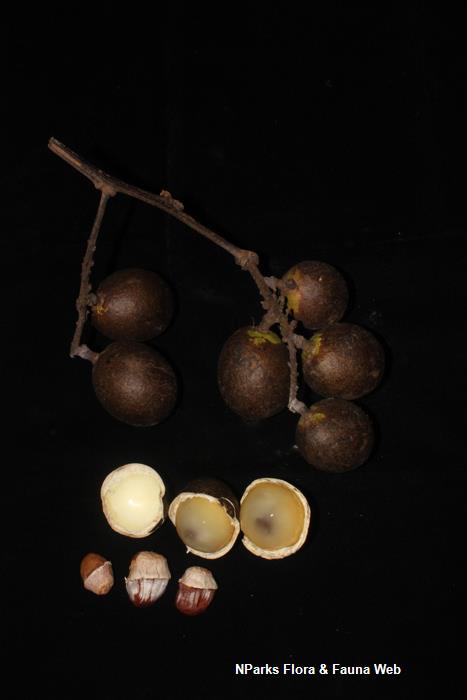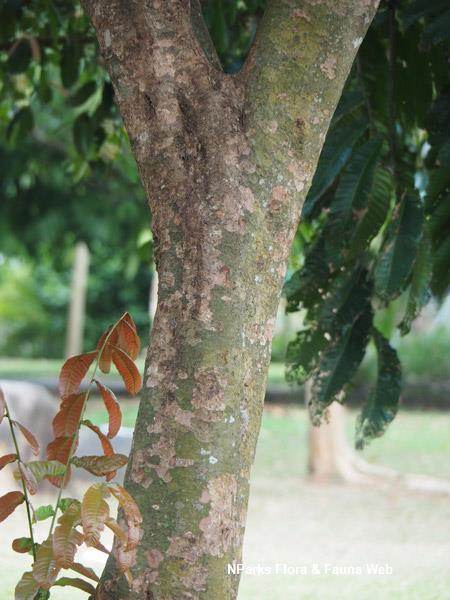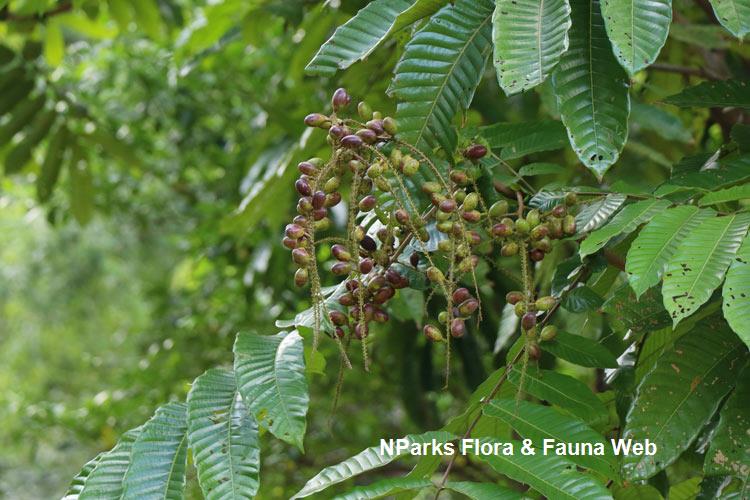
Back
Pometia pinnata J.R.Forst. & G.Forst.
| Family Name: | Sapindaceae |
| Synonyms: | Pometia alnifolia Radlk., Pometia gracilis King |
| Common Name: | Island Lychee, Lansir, Pacific Lychee, Fijian Longan, Kasai Daun Besar, Kasai Langsir, Kelisar, Obahu, Kawa, Tawa, 番龙眼 |
Name
Classifications and Characteristics
| Plant Division | Angiosperms (Flowering Seed Plants) (Dicotyledon) |
|---|---|
| Plant Growth Form | Tree |
| Lifespan (in Singapore) | Perennial |
| Mode of Nutrition | Autotrophic |
| Plant Shape | Broad / Mushroom / Hemispherical |
| Maximum Height | 50 m |
Biogeography
| Native Distribution | From south China and Sri Lanka, through Southeast Asia to the Pacific Islands |
|---|---|
| Native Habitat | Terrestrial (Primary Rainforest, Secondary Rainforest, Monsoon Forest, Freshwater Swamp Forest, Riverine) |
| Preferred Climate Zone | Tropical, Sub-Tropical / Monsoonal |
| Local Conservation Status | Native to Singapore (Endangered (EN)) |
Description and Ethnobotany
| Growth Form | It is a tree up to 50 m tall, with spreading buttresses up to 5 m tall. |
|---|---|
| Foliage | It has alternate, stalked, compound leaves that are more than 1 m long. Each leaf consists of 4–15 pairs of leaflets, and lacks a terminal leaflet. The papery to leathery leaflets are egg-shaped to drop-shaped, slightly to distinctly sickle-shaped, red when young, dark green above and lighter green below when mature, hairless to covered with hair, 6–40 by 2–13 cm, and with toothed margins. The lowest pair of leaflets is smaller than others, round, ear-shaped or cushion-shaped, 0.4–3 by 0.3–5 cm, appearing like a stipule, and with one of the leaflets reduced. |
| Flowers | The plant is monoecious, producing both male and female flowers in the same individual. The flowers are about 2–2.5 mm across, generally white to green-yellow, and occur on branched flowering stalks that are 15–70 cm long. |
| Fruit | Its fleshy fruits have a stony core each. Its fruit is ellipsoid to round, 1.5–5 by 1–3 cm, and red turning black when ripe. The seed is egg-shaped, unequal sided, up to 2.5 by 1.5 cm, brown, and with a white covering (aril). |
| Habitat | It can be found in primary and secondary forests, up to 1700 m altitude, and is common on riverbanks. It occurs locally in Bukit Timah Nature Reserve, Central Catchment Nature Reserve (including Mandai and Nee Soon Swamp forests), Changi, and Pulau Tekong Kechil. |
| Associated Fauna | Its flowers are insect-pollinated. Its fruits and seeds are probably eaten and dispersed by small mammals, bats and birds. The lowest pairs of leaflets, that are stipule-like, are usually inhabited by ants. |
| Cultivation | It can be propagated by seed. |
| Etymology | Pometia, commemorating P. Pomet, a French writer; Latin pinnata, referring to the pinnate leaves of this species |
| Ethnobotanical Uses | Edible Plant Parts : Edible Fruits Food (Fruit or Vegetable): Fruits eaten fresh, with juicy sweet pulp that resembles Litchi chinensis (Lychee). Seeds roasted or boiled. Leaves used for chewing with lime. (Herb or Spice) Medicinal: Plant reported to have antiseptic properties (probably due to presence of saponins). Bark used by Malays and Indonesians to treat sores and wound infections. Leaves and bark used to make bathwater for fever. Timber & Products: General-purpose wood used for construction, furniture, flooring and various items. Wood also burnt as firewood and charcoal. |
Landscaping Features
| Landscaping | It is often cultivated along streetscapes, in parks and gardens for its attractive new foliage and bushy crown. |
|---|---|
| Desirable Plant Features | Ornamental Foliage |
| Landscape Uses | Suitable for Roadsides, General, Parks & Gardens, Riverine |
| Thematic Landscaping | Naturalistic Garden |
Fauna, Pollination and Dispersal
| Pollination Method(s) | Biotic (Fauna) (Insects (Bee)) |
|---|---|
| Seed or Spore Dispersal | Biotic (Fauna) (, Vertebrates (Bat)) |
Plant Care and Propagation
| Light Preference | Full Sun |
|---|---|
| Water Preference | Lots of Water, Moderate Water |
| Plant Growth Rate | Moderate |
| Rootzone Tolerance | Moist Soils, Well-Drained Soils, Fertile Loamy Soils |
| Maintenance Requirements | Moderate |
| Propagation Method | Seed |
Foliar
| Foliage Retention | Evergreen |
|---|---|
| Mature Foliage Colour(s) | Green |
| Mature Foliage Texture(s) | Leathery, Raised / Sunken Veins, Thick, Papery |
| Prominent Young Flush Colour(s) | Red, Orange |
| Foliar Type | Compound (Odd-Pinnate) |
| Foliar Arrangement Along Stem | Alternate |
| Foliar Attachment to Stem | Petiolate |
| Foliar Shape(s) | Non-Palm Foliage (Ovate, Obovate) |
| Foliar Venation | Pinnate / Net |
| Foliar Margin | Serrate / Toothed |
| Leaf Area Index (LAI) for Green Plot Ratio | 3.0 (Tree - Intermediate Canopy) |
Non - Foliar and Storage
| Trunk Type (Non Palm) | Woody |
|---|---|
| Bark Colour(s) | Reddish Brown |
| Stem Type & Modification | Woody |
| Root Type | Underground (Tap Root, Fibrous Root), Aboveground (Buttress Root) |
Floral (Angiosperm)
| Flower & Plant Sexuality | Unisexual Flowers , Monoecious |
| Flower Colour(s) | Cream / Off-White, Green, Yellow / Golden |
|---|
| Flower Grouping | Cluster / Inflorescence |
| Flower Location | Axillary |
| Inflorescence Type | Panicle |
Fruit, Seed and Spore
| Mature Fruit Colour(s) | Red |
|---|---|
| Fruit Classification | Simple Fruit |
| Fruit Type | Fleshy Fruit , Drupe |
Image Repository
Others
| Master ID | 1791 |
|---|---|
| Species ID | 3084 |
| Flora Disclaimer | The information in this website has been compiled from reliable sources, such as reference works on medicinal plants. It is not a substitute for medical advice or treatment and NParks does not purport to provide any medical advice. Readers should always consult his/her physician before using or consuming a plant for medicinal purposes. |

